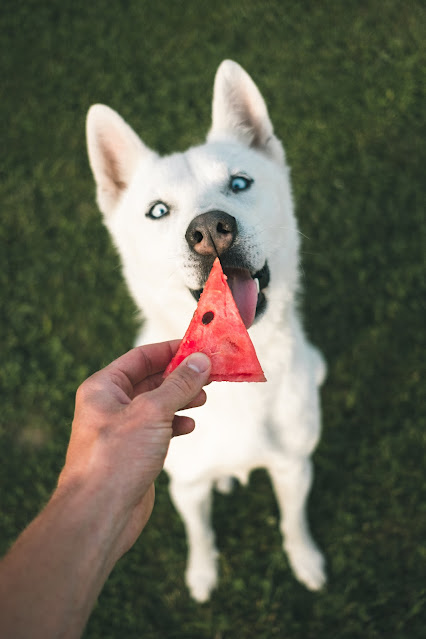Hello everyone!
Last Friday, I wrote a blog post about surviving a heatwave. Since the Cerberus heatwave started, I can't concentrate on much else! In today's post, I will focus on the dangers of heat waves for our pets.
Heatwaves can pose serious risks to our furry friends. Unlike humans, pets cannot regulate their body temperature as effectively, making them more susceptible to heat-related illnesses. When we become overheated, we sweat. Dogs, on the other hand, do not. High temperatures can lead to dehydration, heat exhaustion, and even heatstroke in pets.
 |
Watermelon makes a refreshing and hydrating treat |
Tips for keeping your pets cool and hydrated:
First, make sure your pets have access to fresh, clean water at all times. Consider placing multiple water bowls in different areas of your home or yard. You can also add ice cubes to their water bowl to help keep it cool throughout the day. Another great way to keep your pets hydrated is by offering them frozen treats made from pet-friendly ingredients, such as watermelon. These tasty treats not only provide hydration but also offer a refreshing break from the heat.
It's important to avoid leaving your pets in hot cars or outside in direct sunlight for extended periods. Instead, create shaded areas using umbrellas, tarps, or a doggy tent. Limit outdoor activities to cooler parts of the day, such as the early morning or late evening. Lastly, consider investing in cooling products specifically designed for pets, such as cooling mats or vests. These products can help regulate your pet's body temperature and provide relief from the heat.
Creating a safe and comfortable environment for your pets:
One of the most important things you can do is provide ample shade for your pets. This can be achieved by closing curtains or blinds to block out direct sunlight and using fans or air conditioning to keep the temperature down. It's also crucial to ensure proper ventilation in your home, as stagnant air can make the heat even more unbearable for your furry friends. Keep windows open or use fans strategically to promote airflow. Another aspect to consider is the flooring surface. Avoid surfaces that can become hot and burn your pet's paws, such as asphalt or concrete. This can also increase body temperature and lead to overheating. Opt for grassy areas or provide cooling mats for them to lay on.
Further, be mindful of the humidity levels in your home. High humidity can make it harder for pets to cool down; using dehumidifiers or running air conditioners can help create a more comfortable environment. Lastly, remember to never leave your pets unattended near pools or bodies of water. Not all pets are natural swimmers, and accidents can happen.
Recognising signs of heatstroke in pets and taking action:
As responsible pet owners, recognising the signs of heatstroke in our furry companions and taking immediate action is essential. Heatstroke occurs when a pet's body temperature rises to dangerous levels, and it can be life-threatening if not addressed promptly. Some common signs of heatstroke in pets include excessive panting, drooling, rapid breathing, lethargy, vomiting, and even collapse. If you notice any of these symptoms, you must act quickly.
The first step is to move your pet to a cool, shaded area away from direct sunlight. You can use wet towels or a spray bottle to gently cool them down, focusing on their head, neck, and paws. Avoid using ice-cold water, as this can constrict blood vessels and hinder the cooling process. Next, contact your veterinarian immediately for further guidance and assistance. They may recommend bringing your pet in for a check-up. While waiting for professional help, monitor your pet closely and provide them with water to prevent dehydration.
Heatstroke can be a serious medical emergency, so never hesitate to seek veterinary care.
Additionally, do not shave your pets! A pet's coat is naturally designed to keep it cool during the summer and warm in the winter. Leave at least an inch of hair to protect the skin from sunburns. And last but not least, if you spend time in the sun with your pet (not recommended during a heatwave), apply a pet sunscreen to the least hair-covered spots: bellies, ears, and nose.
Stay safe, and keep your furry friends safe!
Talk soon,

It makes me so angry seeing people walking their dogs when it's in the high 20's or even 30's, how irresponsible. When I had a dog, we were always buying cool mats and things for him in the Summer and making sure he was as comfortable as possible.
ReplyDeletePets are part of the family and they should be treated as such!
DeleteIf it’s too hot for you, it’s definitely too hot for your dogs! I wish more people would have that common sense! I personally don’t have a dog but most people in my community tend to walk their dogs in the early morning or late evening when it’s not as hot. This is such a great post for anyone who does have a dog!
ReplyDeleteI'm glad you liked the post.
DeleteThis is a great reminder that pet owners need to be aware of the dangers their beloved animals will experience. I know that where I live we are experiencing some really hot weather so I hope people take advice on how to keep themselves and their pets as safe as possible. Thanks for this!
ReplyDeleteI'm glad you liked this post!
Delete